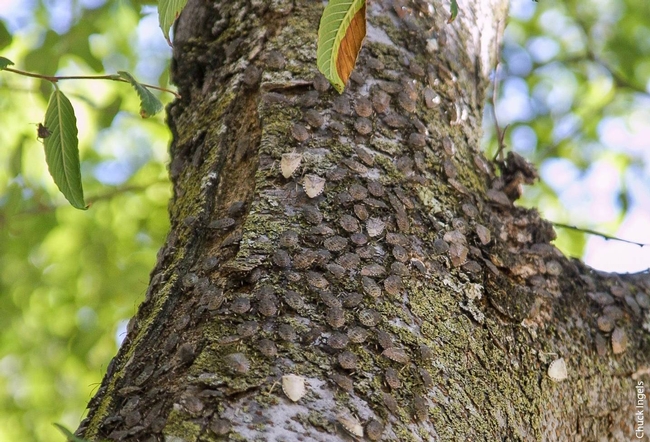
Posts Tagged: Brown marmorated stink bug
Summer heat is suppressing brown marmorated stink bug
The sweltering summer of 2017 has a silver lining. When the temperature rises above 104, brown marmorated stink bug population growth is significantly slowed, reported Debbie Arrington in the Sacramento Bee.
An invasive pest from Asia, brown marmorated stink bugs showed up in midtown Sacramento in 2013. Their spread to commercial crops has been a concern. The stink bugs feed on dozens of California crops, including apples, pears, cherries, peaches, melons, corn, tomatoes, berries and grapes, said Chuck Ingels, UC Cooperative Extension advisor in Sacramento County. Feeding on fruit creates pock marks and distortions that make the fruit unmarketable. In grapes, berries collapse and rot increases.
In 2014 and 2015, the bugs' numbers continued to rise. In early 2016, Ingels feared a population explosion, but a heat wave in July, with seven days at 100 degrees or higher, plus two days at 104, wiped them out.
“This year, BMSB started off at historic lows (since 2013),” Ingels said. “Then, the June heat wave hit and the population that was there plummeted. Most of our trap counts for the last few weeks have been at or near zero, whereas there's usually a peak in June. So, it seems to be proof that temperatures over 100 for extended periods reduces the population – probably especially eggs and nymphs."
Ingels and UC Davis entomologists are studying the connection between high heat and stink bugs in the lab, where the pest is exposed to extreme temperatures. One hour at 113 degrees killed all the bugs, but mortality was also high over 104 degrees.
UC and CDFA researchers make progress in fight against exotic brown marmorated stink bugs
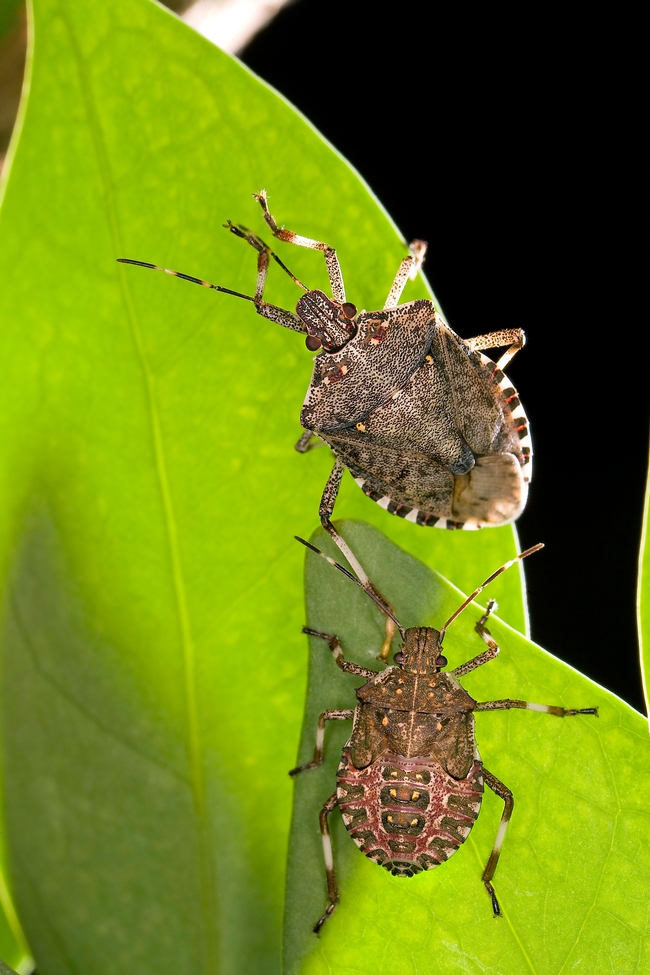
The wasp, Trissolcus japonicus, has scientists feeling hopeful, said Chuck Ingels, UC Cooperative Extension advisor in Sacramento County and one of the 10 authors of the article. Ingels and a team of UC and California Department of Food and Agriculture scientists have been closely monitoring BMSB since large populations were found in downtown Sacramento in 2013.
“We hope T. japonicus will render BMSB a much lower threat, to where it might end up a background stinkbug,” Ingels said. “It all depends on how well the parasitoid adapts to our climate if we get to the point of releasing it.”
At the moment, BMSB has not caused significant damage to agricultural crops in California, but UC scientists want to be ready with solutions should it migrate into farms. BMSB – a native of China, Korea, Japan and Taiwan – made its way to the East Coast of the U.S. in the 1990s. By 2010, it caused millions of dollars in crop damages in apples, peaches and vegetables. The pest was first detected in California in 2002. It is now in urban communities in Siskiyou, Butte, Sutter, Yolo, Sacramento, San Joaquin, Stanislaus, Santa Clara and Los Angeles counties.
In urban areas, the pest is a nuisance. Bugs aggregate in late summer on walls and trees, and then seek refuge in the winter inside homes, garages and other buildings. Massive aggregations of BMSB are a disturbing sight and emit a pungent cilantro-like odor. In restaurants, BMSB can alarm patrons when the insects are mistaken for cockroaches, potentially hurting the eatery's bottom line.
“Apartment managers complain that tenants are threatening to move out because of the stink bugs,” Ingels said. “It's an economic issue.”
But BMSB's potential for damage in commercial agricultural crops portends a much greater economic threat. BMSB's host plant range of 170 species includes many valuable fruit, nut, vegetable and ornamental crops. In August and September of 2015, BMSB was found feeding on citrus, persimmons and apples in a Sacramento community garden. In July 2015, BMSB was found for the first time in traps placed close to citrus, kiwi and avocados in Los Angeles County backyards.
Already, several “generalist predators” have been observed feeding on BMSB – such as lacewings, mantids, earwigs, lady beetles, assassin bugs, pirate bugs, big-eyed bugs and spiders. Field research has also found that at least 12 North American species of stink bug egg parasites will lay eggs in BMSB egg masses.
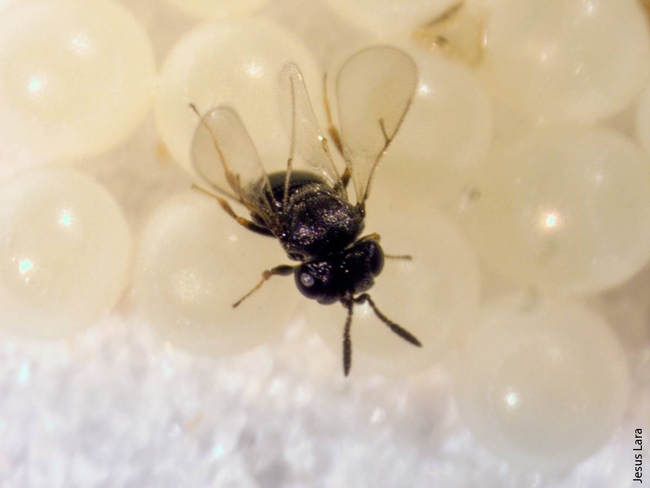
“The introduction of a beneficial natural enemy like T. japonicus, which co-evolved with BMSB in China, increases our chances of successfully targeting and suppressing BMSB populations in the United States,” said Ricky Lara, a post-doctoral scholar at UC Riverside and lead author of the article. “In California, UC and CDFA researchers will continue to conduct the required safety evaluations with T. japonicus to deliver a cost-effective BMSB biological control program.”
Without being introduced by authorities, T. japonicus have been found in Maryland, Virginia and Vancouver, Wash., presumably having been accidentally introduced via parasitized BMSB eggs from Asia. DNA analyses determined that the T. japonicus collected in the field did not originate from the populations in quarantine, indicating that there have been no accidental escapes from these secure facilities.
The California research was funded with a grant from the CDFA Specialty Crop Block Grant Program, which was awarded to Charles Pickett, CDFA senior environmental scientist specializing in biological control, and Mark Hoddle, UC Cooperative Extension biological control specialist. Funding was also provided by the USDA Farm Bill, the California Pistachio Research Board, the Pear Pest Management Research Fund and the Consolidated Central Valley Table Grape Pest and Disease Control District.
Invasive stink bugs found in Stanislaus County
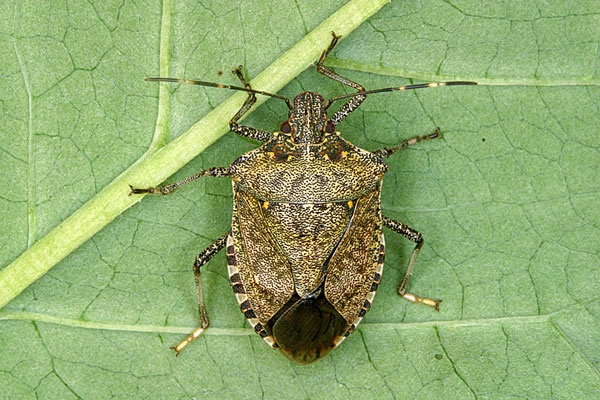
The stink bugs pose a threat to a wide variety of plants, including home-grown and commercial ornamentals, fruits, vegetables and nuts, said Jhalendra Rijal, the area integrated pest management advisor with UC Agriculture and Natural Resources. Rijal is based at the UC Cooperative Extension office in Modesto.
BMSB was found in two Stanislaus County locations in recent weeks: outside a business at Kansas Avenue and Highway 99 in Modesto and outside the home of a pest control adviser in Turlock. Rijal said there have been no reports of BMSB in the county's farmland, but they could be out there.
"There is definitely potential for this pest, because it can feed on many host plants in agricultural and urban settings," he said.
The Modesto Bee quoted the UC IPM Pest Note on brown marmorated stink bug in its article.
"An efficient way to collect stink bugs indoors is by sucking them up with a dry or wet vacuum," the Pest Note says. "The bugs will cause the collection canister or bag and other parts of the vacuum to give off an unpleasant stink bug odor, so some people dedicate a vacuum cleaner to stink bug capture only."
The pest note provides detailed information on monitoring for and managing stink bug infestations.
Brown marmorated stink bugs expected to have a 'banner year'
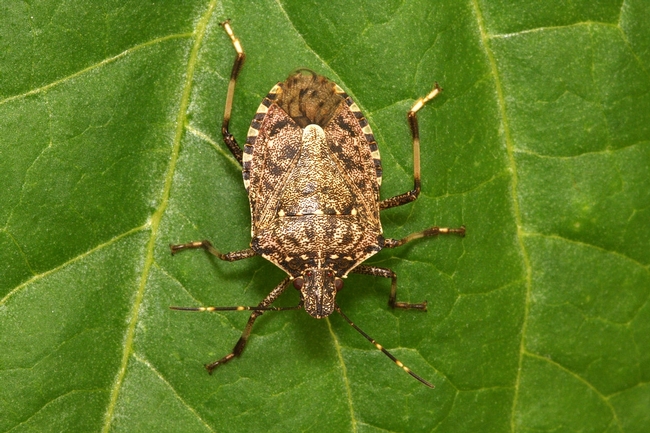
Chuck Ingels, UC ANR Cooperative Extension advisor in Sacramento County, said BMSB was first spotted in 2013 in Sacramento and each year the numbers have grown. This year, the warm spring gave BMSB a head start, portending significant population growth in August and September 2015.
"We're very concerned about tree crops, tomatoes, peppers, corn, beans and other crops," Ingels said. On a bright note, he said California farms do not have forests surrounding them like farmers back East, where growers have been dealing with BMSB since the the mid-1990s. "BMSB is an arboreal species. They live in trees and then come into the farm. We're not sure how much of a problem it will be on farms here (in California)."
Ruyak asked whether any control solutions can be found in the pest's native territory or from farmers back East.
"Growers are using pesticides back East," Ingels said. "There is a parasitoid from China that is under study in labs to see if they pose a problem for native stink bugs and other bugs."
One possible solution for dealing with the pests in gardens is planting sunflowers. Because BMSB are strongly attracted to sunflowers, they may draw the pests away from other crops and allow gardeners to monitor the BMSB presence. On the other hand, sunflowers may actually attract BMSB to the garden, where they could feed on vegetable crops.
BMSB feeds with a mouthpart called a "proboscis," stinging developing fruit 1/4 to 3/8 inch deep and sucking out its juices. As the fruit ripens, it hardens and deforms, becoming inedible.
Read more about BMSB, how to identify it, and methods to manage it around homes and gardens in the UC IPM Pest Note: Brown Marmorated Stink Bug.
Nightmare in midtown: Brown marmorated stink bugs

"Wow, I'm being overwhelmed with calls about brown marmorated stink bugs getting into people's home, as well as restaurants and businesses," said Chuck Ingels, UC Cooperative Extension advisor in Sacramento County. "It's that time of year again!"
When days get shorter and cooler, the BMSB start looking for a place to spend the winter. Frequently, that's inside homes and buildings.
Ingels told the reporter he is keeping track of the BMSB invasion. Residents are asked to fill in an online survey to report BMSB finds. For identification help, residents may deliver BMSB in a sealed plastic bag or container to the UCCE office, 4145 Branch Center Road, Sacramento, or they can email clear photos to cesacramento@ucanr.edu.
Ingels said fairly large populations of BMSB have been found in Citrus Heights near Auburn Boulevard and River Park north and west of CSU Sacramento.
"Most of the others are single finds," he said.
For more information on BMSB identification and management, read a Pest Note posted by the UC Integrated Pest Management program.

